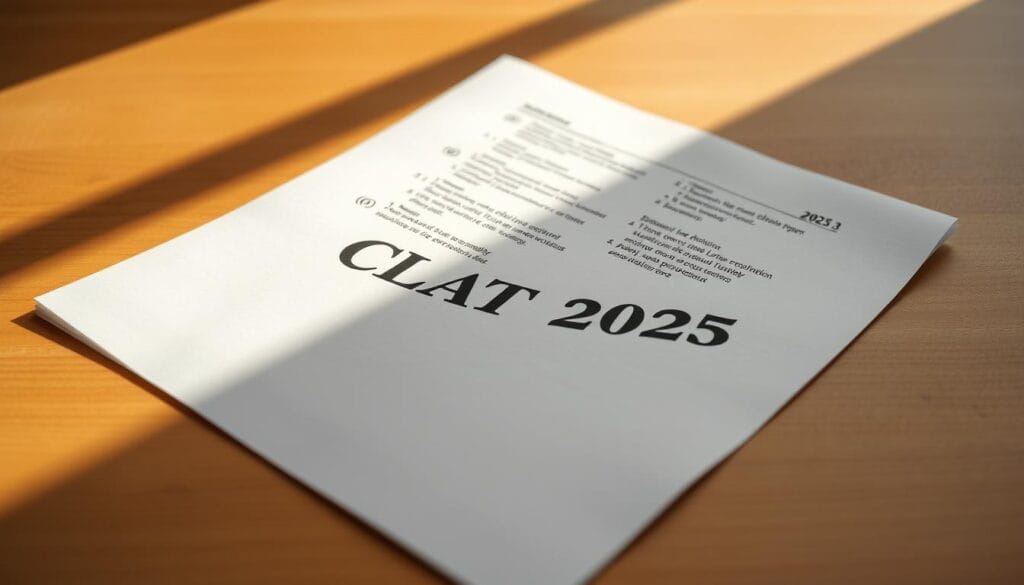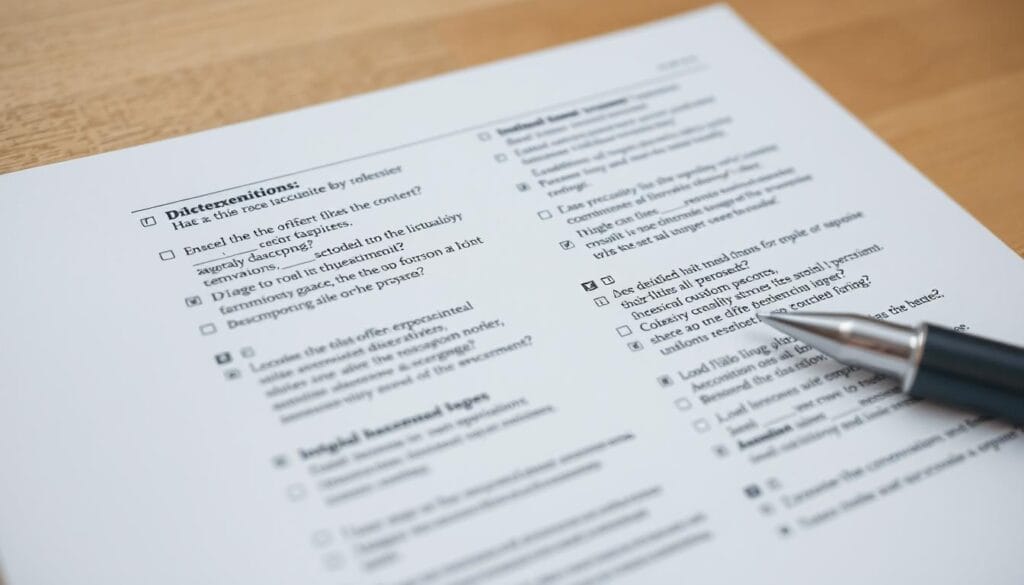Surprising fact: over 60% of test-takers found the exam more approachable than expected, despite a steady mix of easy and moderate items.
The full CLAT 2025 question paper, from the test held on December 1, 2024, is now available for your review. You can use this analysis to sharpen your study plan and benchmark your attempts.
Overall difficulty stayed student-friendly and echoed the pattern from the previous year. Legal Reasoning, GK/Current Affairs, and English offered clear scoring chances, while Logical Reasoning and Quantitative Techniques asked for tighter timing and focus.
The test had 120 questions across five sections and used a +1/−0.25 marking scheme. This format shaped ideal strategies around selective attempts, accuracy, and pacing.
In the sections that follow, you will get concise breakdowns, actionable insights, and pointers on where to gain marks faster so you can plan targeted practice before the next law entrance tests.
Key Takeaways
- Official 2025 question paper is released for thorough review and prep.
- Overall difficulty mirrored the prior year and felt student-friendly.
- Legal Reasoning, GK, and English were scoring, while Logic and Quant were tougher.
- 120 questions and +1/−0.25 scoring make accuracy more valuable than guesswork.
- Use section-wise patterns to refine timing and practice focus.
- Analyze your attempts to spot gaps and gain quick marks.
Quick Access: Download CLAT 2025 Question Paper PDF
Download the official 2025 question paper PDF to review every section and simulate the two-hour test. The file contains all five sections, 120 questions, and the standard marking of +1 for correct and −0.25 for incorrect.

You can download clat in one click from the official website and store the file on your device. Save it in your year-wise folders so you can access it during offline study sessions.
“Use the PDF to recreate exam timing: 120 minutes and 120 questions give you a real test feel.”
- One-click access to the full question paper for focused practice.
- Print selected pages for drills, annotate passages, and mark tricky questions to revisit.
- Cross-check answers with the answer key once released to estimate your probable score.
- Plan at least two timed re-sits — before and after targeted study of weak areas.
Following this routine will help you organize resources, tighten pacing, and convert practice into points in future attempts.
CLAT 2025 Question Paper: What’s Inside and Why It Matters
This year’s test preserved the classic five-section format, with emphasis on reading and applied reasoning.
The 2025 question paper matched the prior year’s layout: 120 MCQs across English Language, Current Affairs (GK), Legal Reasoning, Logical Reasoning, and Quantitative Techniques.
Weightage split mattered. GK and Legal held about 25% each, English and Logical about 20% each, and Quant near 10%.
Why that distribution helps you: focusing on GK and Legal can lift your score quickly, while steady English and logical practice preserves accuracy.

You will see question types that demand different skills: principle application, inference, and data interpretation. Each area asks you to read fast and reason clearly.
“Analyze this paper to sharpen reading speed, precision, and conceptual clarity.”
- You can map study time to the sections that give higher returns.
- Use targeted drills for argument analysis and data comprehension.
- Turn these insights into a weekly plan that boosts both accuracy and confidence.
Official CLAT 2025 Answer Key: Provisional to Final Explained
The consortium posts a provisional answer key soon after the exam so you can cross-check responses quickly.
How to check and use the provisional key: visit the Consortium of NLUs website, log in with your credentials, and open the provisional file. Tally correct and incorrect responses and apply the formula Score = Correct − (Incorrect × 0.25) to estimate your marks.
Window, grounds, and process to raise objections
There is a limited objection window. Use the portal’s “Raise Objections” option, pick the question number, state the proposed correct answer, and add a short, credible justification with sources.
- Only portal submissions count — no calls or emails.
- Acceptable grounds include mis-keyed answers or ambiguous options backed by reliable sources.
- Save copies of confirmations for your records.
Final key release and score updates
A grievance panel reviews objections and then publishes the final 2025 answer key. Accepted changes update section-wise and overall scores before official results. Use this timeline to plan reviews within 24–48 hours and file any objections early.
“Download the provisional key immediately and file objections well before the deadline.”
CLAT 2025 Exam Pattern and Marking Scheme at a Glance
Understanding the test layout helps you plan each two-hour session. The format is simple: a total of 120 questions to be solved in 120 minutes across five sections.
| Section | Typical number | Approx. weightage |
|---|---|---|
| English Language | 22–26 | ~20% |
| General Knowledge | 28–32 | ~25% |
| Legal Reasoning | 28–32 | ~25% |
| Logical Reasoning | 22–26 | ~20% |
| Quantitative Techniques | 10–14 | ~10% |
Marking rules and negative marking strategy
Scoring is +1 for correct and −0.25 for incorrect. Unattempted items carry no penalty.
Adopt a risk-based approach: attempt certain answers first and guess only when you can eliminate two options. Tackle your strongest sections early to build momentum and bank marks.
- Plan target attempts per section from mock data and the ranges above.
- Use a simple performance grid to log attempts, accuracy, and time spent.
- Favor accuracy over reckless coverage to limit negative impact from wrong answers.
Overall Difficulty Level: CLAT 2025 vs CLAT 2024 and CLAT 2023
Comparing recent years shows how the exam’s difficulty level settled after a notable spike in 2023.
In brief, clat 2025 felt largely easy and close to the student-friendly year of 2024. The tougher 2023 year produced lower topper scores and sharper cut-offs.
Why that matters: the 2024 shift to a 120-mark format became the new normal in 2025. That made pacing and target attempts more predictable for you.
- Steady sections: Legal, GK, and English stayed accessible and offered reliable scoring chances.
- More analysis needed: Logical reasoning and Quant demanded careful thinking and time control.
| Year | Overall difficulty | Topper impact |
|---|---|---|
| 2023 | Challenging | Lower topper marks; tighter cut-offs |
| 2024 | Student-friendly | Normalized scores after format change |
| 2025 | Similar to 2024 (easy) | Predictable targets and time budgets |
“Aim for accuracy in steady sections and reserve extra time for analysis-heavy questions.”
Use this trend to set realistic score targets and time budgets per section. Focus your revision on reading speed, inference skill, and data-led accuracy for better returns in law exams.
Section-Wise Analysis: English Language
The English section offered a clear scoring path with passages that tested close reading and inference.
You encountered 24 questions in this section, set at an easy-to-moderate level. A solid performance here could add quick, reliable marks to your total.
Good attempts fall in the 22–24 range if your accuracy on inference items held up. Average returns clustered around 20–22 for most test-takers.
Key themes and skills
Passages came from fiction and the education system. Expect tone, main idea, and the author’s argument to be tested.
Work on inference, assumption spotting, and contextual vocabulary to turn borderline items into sure marks.
Actionable strategy
- Skim to map passage structure, then scan for details to cut rereads.
- Log repeated misses — titles and subtle inference traps — and make mini-drills around them.
- Eliminate extreme or out-of-scope options quickly to improve your accuracy under time pressure.
“Focused practice on inference and scanning will give you the best return in this section.”
Section-Wise Analysis: GK and Current Affairs
GK and current affairs formed a high-yield block that rewarded steady daily reading and timely revision. The section had about 28 questions at an easy level, so quick recall gave you a real scoring edge.
Topics clustered around BRICS, the Civil Disobedience Movement, the Women Reservation Bill, Article 370, and the Olympics. A strong attempt was around 20 correct answers; average performance settled near 15.
Difficulty insights and preparation window
The questions were visible-event driven and often relied on simple factual links to static context. That made many items straightforward if you had steady notes.
- Plan a rolling six-to-nine-month prep window for dynamic news and static history.
- Use daily briefs and monthly compendiums to retain testable facts efficiently.
- Create issue-wise sheets (BRICS timeline, Olympic medallists, key constitutional changes) for quick revision.
“Prioritize breadth with targeted depth on recurring areas — this balances coverage and recall.”
Track your common errors — wrong dates, missed names, and similar-sounding policies — and fix them with spaced repetition. This focused routine turns general reading into reliable marks in this public examination section.
Section-Wise Analysis: Legal Reasoning
In this legal reasoning block, you faced about 32 questions that were generally easy and direct.
High-yield areas included the Right to Privacy, Environmental Law, the Juvenile Justice (JJ) Act, general interpretation, and disputes over void versus voidable agreements. There were also items on cheating in public examination settings.
How to target these areas
You should extract the operative rule from each passage before applying it to facts. Avoid relying on outside knowledge unless a question explicitly asks for it.
Focus on quick principle-to-fact mapping across Privacy, Environmental Law, JJ Act, GI, and contract topics to secure fast marks. Typical traps mix up void and voidable or overextend a doctrine beyond the passage’s facts.
Practice and scoring strategy
Practice timed sets and build flash summaries of doctrines and exceptions to speed comprehension mid-test. Drill explanations for missed items to see how subtle fact changes flip conclusions.
| Metric | Value | Action |
|---|---|---|
| Questions in section | ~32 | Attempt strong passages first |
| Good score band | 27–30 | Aim for accuracy, not guesses |
| High-yield topics | Privacy, Environment, JJ Act, Contracts | Make one-page doctrine notes |
| Common traps | Void vs voidable; over-extension | Highlight in notes and drill |
“Use the relative ease of this section to build a cushion against tougher logical or quantitative items.”
- Practice extracting rules, then apply to facts quickly.
- Create short flash summaries for each doctrine and its exceptions.
- Review missed explanations to understand where applications changed the outcome.
Section-Wise Analysis: Logical Reasoning
Moderate difficulty and dense passages made time the deciding factor in this block.
You dealt with about 24 questions that tested inference, strengthening, title choice, and indirect inference.
Passage complexity, inference types, and time traps
Start by mapping claims, evidence, and assumptions before you read answer choices. This quick map saves time and avoids misleading options.
Watch for time traps: some long passages yield few solvable items. Skip those early and return if time allows.
- Elimination tactics: spot extreme or out-of-scope choices and remove them fast.
- Indirect inference: pick answers that are supported but not overstated by the passage.
- Per-passage ceiling: set a firm time limit so later sections don’t suffer.
Log the question types you miss and run short micro-drills to fix those gaps. Use the clat 2025 question review as a practice source for this information.
“Treat accuracy and pacing as equal priorities; one without the other reduces score potential.”
Section-Wise Analysis: Quantitative Techniques
The quantitative segment was brief but consequential. With about twelve questions, most items focused on percentages and basic data interpretation. The limited number meant each error had a magnified effect on your score. For more insights on preparing for this section, this will take you to the CLAT syllabus for 2026.
Focus on percentages and data interpretation
Target core concepts: percentage conversions, ratios, and quick DI reads. Pre-memorize common fraction-percentage-decimal equivalences to cut down calculation time.
Accuracy over volume: maximizing limited questions
A good score band was 8–9 correct answers. Adopt a strict pacing cap: move on if a question takes more than one minute. Use a checklist for DI prompts—units, totals, base values, and percentage change—to avoid misreads.
- Keep a correction journal for arithmetic slips and review weekly.
- Practice set-by-set pacing to respect the overall time budget.
- Prioritize high-confidence items first to build a safe score cushion.
| Metric | Value | Action |
|---|---|---|
| Number of questions | ~12 | Attempt strong items first |
| Good score | 8–9 | Focus on accuracy, not guesses |
| Primary areas | Percentages, DI | Memorize conversions; use checklist |
| Time cap | ~1 minute per question | Skip and return if stuck |
“Make every numeric attempt count: when the section is small, precision beats volume.”
Calculate Your Score Using the CLAT 2025 Answer Key
Reconcile your answer sheet with the provisional key to generate a preliminary score and section-wise snapshot.
Use this formula: Score = Total correct − (Total incorrect × 0.25). Tally each response against the official 2025 answer key. Unattempted items carry no penalty.
- Gather your marked responses and reconcile them with the provisional answer key to compute an initial score.
- Apply the scoring formula precisely, subtracting 0.25 for each incorrect attempt and ignoring unattempted items.
- Segment your tally by section to spot where accuracy dipped and where you did well.
- Record mismatches and keep evidence if you plan to file an objection against any question in the key.
- Estimate your percentile using marks-vs-rank trends once those trends are released to calibrate counseling expectations.
- Keep a snapshot of this score for comparison after the final key is published; it helps track changes.
“Compute carefully and save your records — the provisional key gives you fast, actionable information.”
How to Use the CLAT 2025 Question Paper for CLAT 2026 Prep
A timed re-sit of the 2025 question paper gives clear data on section-wise stamina and error patterns. Run the full test under strict two-hour conditions to mirror real exams and record timing per section.
Diagnose strengths and build a focused plan
After a timed attempt, break down results by section. Note which types of questions cost you marks and which you clear quickly. For more guidance on how to navigate the registration process and prepare effectively, visit this resource.
Use that insight to convert weak areas into weekly drills. For example, if inference items drop accuracy, schedule short daily inference sets.
Simulate conditions and refine pacing
Alternate full-length runs with sectional sprints to build stamina. Treat some sessions as strict mocks and others as practice focused on speed or accuracy.
- Re-sit the full paper in two hours to measure pacing.
- Perform deep-dive analysis by section to map error categories.
- Translate findings into a weekly plan targeting your biggest score leaks.
- Set realistic target attempts for the next year based on data, not guesswork.
“Use mock tests and real tests together to understand difficulty level and sharpen timing.”
Previous Year Question Papers and Answer Keys: Download Hub
A single hub now gathers past year question papers and official answer keys so you can practice efficiently. Use the archive to build a focused plan that pairs real papers with timed mocks.
CLAT 2024 to 2018 PDFs for practice
Download year-wise PDFs from 2018 through 2024 to study format shifts and recurring themes. Organize files by year on your device or a study folder on the website for quick access.
Why PYQs plus mock tests accelerate improvement
Working with previous year papers and regular mock tests compounds learning. You see patterns, sharpen timing, and learn how distractors are built.
- Start with recent years, then work backward to broaden exposure.
- Blend each paper with a timed mock to measure speed and accuracy.
- Create a tracker of frequent themes and record why each answer key choice wins.
| Years | Files | Use | Action |
|---|---|---|---|
| 2024–2022 | PDFs + answer key | Pattern tracking | Prioritize first |
| 2021–2019 | PDFs + answer key | Theme breadth | Mix with weekly mocks |
| 2018 | Historical trends | Study after accuracy stabilizes |
“Pair PYQs with timed mocks to turn passive review into test-ready skill.”
Mock Tests: Building Speed, Stamina, and Accuracy
Timed simulations expose which question types eat your minutes and which give quick marks. Use regular full-length mock tests to convert study into reliable performance.
Plan your week around two focused runs and deeper reviews. After each mock, spend more time reviewing than you did on the attempt.
Structuring weekly mocks and review routines
- Schedule one to two full-length mock runs per week and treat them as real exams.
- Time each section to find pacing bottlenecks and refine your sequence.
- Keep an error log that tags mistakes by concept, reading slip, or poor guesswork.
- Rework missed questions until you can explain the reasoning aloud.
- Insert sectional drills midweek based on the last mock’s weak areas.
- Simulate test-day conditions — fixed start, no interruptions, and strict rules.
| Practice element | Frequency | Primary goal |
|---|---|---|
| Full-length mock | 1–2/week | Build stamina and pacing |
| Section drills | 2–3 midweek | Fix weak topics |
| Error log review | After each mock | Convert errors into learning |
“Treat every mock like the real clat paper — the routine builds speed and the review builds accuracy.”
Post-Exam Essentials: Results, Cut-offs, Counseling, and Ranks
When the final answer key goes live, the results and allotment lists follow shortly on the consortium website. You should confirm your official score and download the result PDF for records.
Next, compare your marks with prior-year cut-offs and available marks‑vs‑rank data to shortlist NLUs realistically. Check how small shifts in a single question or two change rank estimates and choices.
Prepare documents and fill preferences before counseling windows open. Monitor schedules and allotment lists closely and keep scanned copies of ID, category certificates, and fee receipts ready.
- Track result release after the finalized answer to confirm your score.
- Match your marks with past cut-offs and marks‑vs‑rank trends for realistic goals.
- Watch counseling dates and allotment lists on the official site and gather documents early.
- Review fee structures, category seats, and domicile rules to refine choices.
- Follow movement across rounds and keep backup options or a reattempt plan if needed.
| Counseling step | Action | Documents |
|---|---|---|
| Result check | Confirm score on portal | Result PDF, application ID |
| Shortlist | Compare marks vs cut-offs | Rank estimate sheet |
| Allotment | Monitor allotment list | ID, category certificates, fee proof |
“Keep clear records and watch allotments closely — small moves across rounds can change outcomes.”
Use this information to plan seat acceptance or backups. Treat the timeline like any other competitive public examination: timely action matters more than last-minute panic.
Looking Ahead: Key Dates and Actions for CLAT 2026
Key registration dates and a firm test slot give you the structure to shape a realistic study calendar.
Online applications open on August 1, 2025 and close on October 31, 2025. The test day is Sunday, December 7, 2025 from 2:00 PM to 4:00 PM.
Budget the application fee now: Rs. 4,000 for UG/PG and Rs. 3,500 for SC/ST/PwD/BPL. Complete your profile and payment well before the deadline to avoid last-minute issues.
Download the latest information bulletin from the official website when it is released. Review fee rules, document lists, and any changes to the exam format or schedule.
- Plan to peak in November with focused revision cycles and past-year drills.
- Set numeric targets: number of mocks, accuracy thresholds, and sectional attempt goals.
- Use clat 2025 insights to refine content focus and test-readiness checks.
“Calendar the milestones, budget the fee, and make revision cycles non-negotiable.”
| Item | Detail | Action |
|---|---|---|
| Application window | Aug 1 – Oct 31, 2025 | Complete profile early |
| Test date | Dec 7, 2025 | 2–4 PM | Schedule final mocks |
| Fee | Rs. 4,000 / Rs. 3,500 | Arrange payment & receipts |
Key Takeaways from the CLAT 2025 Paper and Strategy Snapshot
This short snapshot turns the recent paper into clear actions you can use in the final months of prep. Focus on what produced marks and where time cost you points.
Core insight: the test rewarded analytical reading and principle application over rote memorization. Legal reasoning and GK remained the most reliable scoring areas.
Logical reasoning and Quant required sharper time control. If a question eats more than a minute, mark and move on.
Make PYQs and weekly mocks the backbone of your routine. They give data you can act on: error types, timing leaks, and section-wise strengths.
- You will prioritise Legal Reasoning and GK for quick gains while tightening timing on Logical and Quant.
- You will adopt a data-driven routine—past-year papers plus weekly mocks—to sharpen accuracy and reduce avoidable errors.
- You will refine test-day sequencing, attempting high-confidence areas first to stabilise your score early.
- You will use the objection window and official answer key wisely to validate scores and next steps.
- You will turn this snapshot into a final-month checklist: reading drills, logic micro-sets, and DI accuracy work.
“Treat high-confidence sections as your cushion; use timed drills to close pacing gaps in tougher areas.”
Use this checklist to build a simple, repeatable week: two full mocks, three targeted drills, and daily short reading sessions. That routine gives you measurable progress and clearer understanding of weak spots as you approach exams.
Conclusion
Use the clat 2025 review to turn data into a short, realistic plan. Calculate your score, note weak topics, and set daily drills that close gaps.
Download clat resources and past question papers to keep practice anchored in real items. Work with previous year sets to see how trends shift over time.
Increase mock tests previous runs and timed re-sits to build speed and stamina. Compare your results to understand difficulty level shifts and refine section targets.
Track official dates closely, practise with the right materials, and focus on steady gains. With focused routines and targeted drills, you will enter law exams more confident and prepared.


